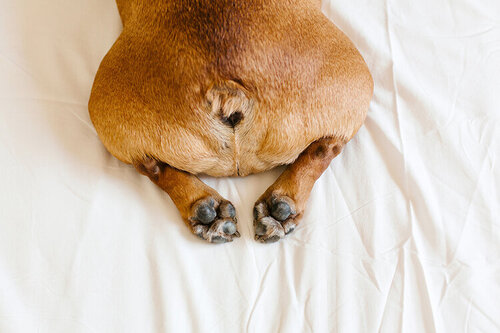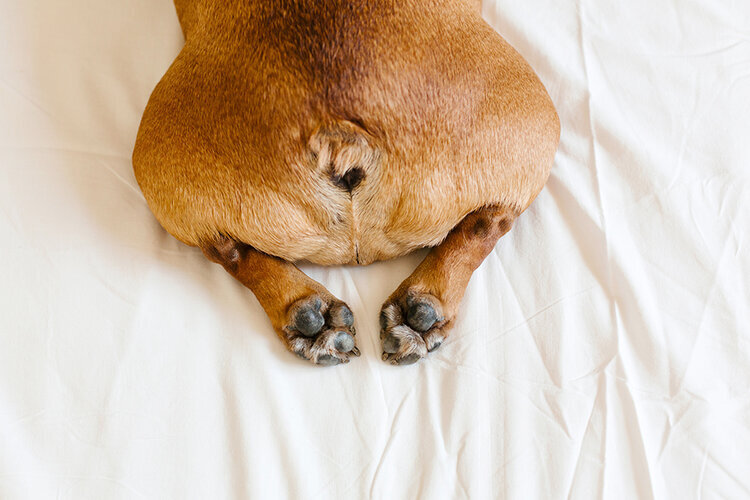Dog’s anal glands typically need to be expressed every 2-3 months to prevent any discomfort or potential health issues. Neglecting to express the anal glands can lead to impaction or the formation of abscesses.
It is crucial to recognize the signs of anal gland issues, such as whining, restlessness, or biting at the hindquarters, to ensure timely expression and prevent complications. Certain breeds, especially smaller ones like Chihuahuas and Toy Poodles, may require more frequent manual expression due to their predisposition to anal gland problems.
Regularly monitoring and addressing your dog’s anal gland health is essential for their overall well-being.

Credit: peterdobias.com
Understanding Dog Anal Glands
Regular expression of a dog’s anal glands can vary, but some dogs may only need it a couple of times a year, while others may require monthly or more frequent expression. It is important to monitor your dog’s behavior and consult with a veterinarian to determine the appropriate frequency for your furry friend.
3 HTML Subheadings: 1.What Are Anal Glands In Dogs?
2.Purpose Of Anal Glands In Dogs
3.Common Issues With Dog Anal Glands
Dog anal glands, also known as anal sacs, are small pouches located on either side of the dog’s anus. These glands produce a foul-smelling fluid that is released when dogs defecate or when they are under stress. While anal glands are a natural part of a dog’s anatomy, they can sometimes cause problems if they become impacted, infected, or irritated.
What Are Anal Glands In Dogs?
Anal glands, in dogs, are two small sacs between the layers of muscles that surround the rectum and anus. These glands contain a fluid that is released through small ducts when pressure is applied, such as during bowel movements or when a dog is frightened or excited.
Purpose Of Anal Glands In Dogs
The main purpose of anal glands in dogs is still somewhat of a mystery. However, it is believed that these glands play a role in marking territory and communicating with other dogs. The strong, unpleasant odor of the fluid produced by anal glands can act as a scent marker, helping dogs establish dominance and communicate their presence to others in the area.
Common Issues With Dog Anal Glands
While anal glands in dogs are a normal part of their anatomy, they can sometimes cause problems. One common issue is when the anal glands become impacted, meaning that the fluid inside the glands does not empty properly. This can lead to discomfort, pain, and potential infections. Dogs may exhibit signs such as scooting their rear end along the ground, licking or biting at their hindquarters, or showing signs of discomfort when defecating.
In some cases, the impacted anal glands can even rupture, leading to an abscess or infection. This can cause a foul-smelling discharge and require veterinary intervention to alleviate the pain and prevent further complications.
Certain dog breeds are more prone to anal gland issues, including small breeds such as Chihuahuas, Toy and Miniature Poodles, Cocker Spaniels, Lhasa Apsos, Basset Hounds, and Beagles. However, anal gland problems can affect dogs of all sizes.
In conclusion, understanding dog anal glands is essential for every dog owner. Monitoring your dog’s anal gland health and being aware of potential issues can help prevent discomfort and ensure your dog’s overall well-being.

Credit: riverroadveterinary.com
Signs And Symptoms Of Full Anal Glands In Dogs
The signs and symptoms of full anal glands in dogs may include discomfort, whining, restlessness, and frequent biting or licking of the hindquarters. The frequency of expressing a dog’s anal glands varies depending on the individual dog and their specific needs.
Behavioral Signs Of Full Anal Glands In Dogs
When a dog’s anal glands are full, they may exhibit certain behavioral signs that indicate their discomfort. These signs can be easily recognized by pet owners. Keep an eye out for the following behavioral signs: – Whining or whimpering: Dogs with full anal glands may vocalize their discomfort by whining or whimpering. – Restlessness: Your dog may become restless, constantly pacing or unable to settle down. – Constantly turning around: If your dog frequently turns around to look at or bite at their hindquarters, it could be a sign that their anal glands are bothering them. – Scooting: Dogs with full anal glands may also scoot their rear end along the ground in an attempt to alleviate discomfort.Physical Signs Of Full Anal Glands In Dogs
In addition to behavioral signs, there are physical signs that can indicate full anal glands in dogs. These signs are important to be aware of to ensure the health and well-being of your furry friend. Look out for the following physical signs: – Swelling or redness: If the anal glands are full, they can become swollen or red around the anus. – Discharge: Dogs with full anal glands may have a foul-smelling discharge from their anal area. – Licking or chewing: Your dog may repeatedly lick or chew their hindquarters as an attempt to relieve discomfort from full anal glands. Table: | Behavioral Signs | Physical Signs | |—————–|—————-| | Whining or whimpering | Swelling or redness | | Restlessness | Discharge | | Constantly turning around | Licking or chewing | | Scooting | – | Remember, it is important to monitor your dog’s anal glands to prevent any discomfort or complications. Regular check-ups with a veterinarian and appropriate expression of the glands when needed can help keep your dog happy and healthy.Frequency Of Expressing Dog Anal Glands
Anal glands in dogs should be expressed as needed, depending on the individual dog. Some dogs may need their anal glands emptied a couple of times a year, while others may require more frequent expression. It is important to monitor your dog’s behavior and consult with a veterinarian to determine the appropriate frequency for expressing their anal glands.
Factors Affecting Frequency
The frequency at which a dog’s anal glands need to be expressed varies depending on several factors. These factors include the size and breed of the dog, their diet, and their overall health. Smaller breeds, such as Chihuahuas and Toy Poodles, are more prone to anal gland issues and may require more frequent expression. Dogs with a high-fiber diet tend to have firmer stools, which can help naturally express the glands. Additionally, dogs with certain health conditions, such as allergies or infections, may require more frequent expression to relieve discomfort.
Recommended Frequency
The recommended frequency for expressing dog anal glands can vary. Some dogs may only need their anal glands expressed a couple of times a year, while others may require more frequent expression. It is best to consult with your veterinarian to determine the optimal frequency for your specific dog. They can assess the condition of your dog’s anal glands and provide guidance based on their individual needs.
How To Express Dog Anal Glands
Properly expressing a dog’s anal glands is essential to avoid injury or discomfort. Here is a step-by-step guide on how to express your dog’s anal glands:
- Prepare the necessary supplies, such as gloves, tissues, and dog-safe lubricant.
- Position your dog in a comfortable and secure position.
- Pull on your gloves to protect your hands.
- Apply a small amount of lubricant to your gloved finger.
- Gently lift your dog’s tail, exposing the anal area.
- Locate the anal glands on both sides of the anus; they will feel like small lumps.
- Using gentle pressure, squeeze the glands towards the anus.
- Be careful not to squeeze too hard or forcefully, as this can cause injury.
- Release the pressure and allow the glands to empty.
- Wipe the area clean with tissues and dispose of them properly.
- Afterward, reward your dog with praise or a treat for their cooperation.
If you are uncomfortable expressing your dog’s anal glands or unsure of the proper technique, it is best to seek assistance from a professional groomer or veterinarian. They have the experience and knowledge to express the glands safely and effectively.

Credit: www.scenthound.com
Frequently Asked Questions On How Often Do Dogs Anal Glands Need To Be Expressed
How Do You Know If Your Dog’s Glands Are Full?
Dogs with full anal glands may show signs of discomfort like whining, restlessness, or biting at their hindquarters. If not expressed, the glands can become impacted and form painful abscesses. Certain breeds, especially smaller ones, may need monthly gland expression.
The frequency of expression varies for each dog.
What Happens If You Don’t Express Your Dog’s Glands?
If you don’t express your dog’s glands, they can become impacted and form an abscess, causing discomfort and pain. This can happen temporarily or persistently. Certain breeds may require monthly expression.
What Dog Breeds Need Their Glands Expressed?
Certain small dog breeds such as Chihuahuas, Toy and Miniature Poodles, Cocker Spaniels, Lhasa Apsos, Basset Hounds, and Beagles may need monthly gland expression. However, anal gland issues can affect dogs of all sizes.
How Often Should You Squeeze A Dog’s Glands?
Dogs’ anal glands should be squeezed when needed, which can vary from dog to dog. Some dogs may require their anal glands to be manually expressed a couple of times a year, while others may need it more frequently, such as every month.
Conclusion
Twice a year. However, the frequency of anal gland expression varies from dog to dog. It is best to consult with your veterinarian to determine how often your dog’s anal glands should be expressed. Regular expression can prevent discomfort, pain, and potential complications.
Proper anal gland care is an important aspect of your dog’s overall health and well-being.



